Cultural depictions of Mary, Queen of Scots
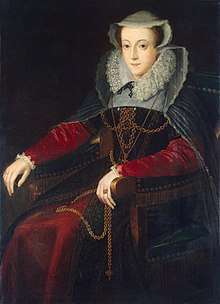
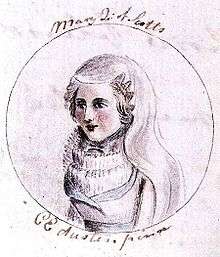
Mary, Queen of Scots, has inspired artistic and cultural works for more than four centuries. The following lists cover various media, enduring works of high art, and recent representations in popular culture, film and fiction. The entries represent portrayals that a reader has a reasonable chance of encountering rather than a complete catalogue.
Fiction
- An early novelistic treatment of Mary is Madame de La Fayette's La Princesse de Clèves (1678), in which the young dauphine features as a major character. Written one and a half centuries later, The Abbot by Sir Walter Scott (1820) covers the period of Mary's confinement in Loch Leven castle. Mary's story has also been the subject of a number of more recent novels, including The Gay Galliard: A Novel of Mary Queen of Scots, by Margaret Irwin (1941); Royal Road to Fotheringhay (1955) and The Captive Queen of Scots (1963) by Jean Plaidy; Mary Queen of Scotland and the Isles: A Novel by Margaret George (1992); Fatal Majesty by Reay Tannahill (2000); and The Other Queen by Philippa Gregory (2008). Mary features importantly in The Lymond Chronicles by Dorothy Dunnett. She is the subject of a short story in Susanna Clarke's 2006 collection of fantasy tales The Ladies of Grace Adieu and Other Stories.
- In children's literature, novels on Mary, Queen of Scots, include: Queen's Own Fool: A Novel of Mary Queen of Scots by Jane Yolen, The Lady of Fire and Tears by Terry Deary, and from the Royal Diaries, Mary, Queen of Scots: Queen Without a Country, France, 1553 by Kathryn Lasky. A Traveller in Time by Alison Uttley is about a young girl who finds herself in the time of and in the company of Anthony Babington, who is attempting to free Mary and overthrow Elizabeth.
- In The Princeling, Volume 3 of The Morland Dynasty, a series of historical novels by author Cynthia Harrod-Eagles, the fictional Lettice Morland becomes embroiled in the dramatic events taking place at the court of Mary, Queen of Scots.
- She is the main character in the young adult historical novel The Wild Queen by author Carolyn Meyer.
- Mary is a main character in ‘‘The Queen’s Consort’’ by Steven Veerapen, in which her second husband, Lord Darnley, is the protagonist.
Theatre
18th and 19th centuries
Mary, Queen of Scots, captured the imagination of Italian radicals and their fellow travellers as a political symbol. There was a restless interest in this tormented figure. The earliest years of the nineteenth century saw performances of the following plays:
- Count Vittorio Alfieri’s Maria Stuarda (1778)
- Mary Deverell's Mary, Queen of Scots; An Historical Tragedy, Or, Dramatic Poem (1792)
- Friedrich Schiller's Maria Stuart (Mary Stuart) (1800). This influential play was the basis for Donizetti's opera amongst others. It was most recently produced in London's West End in 2005, starring Janet McTeer and Harriet Walter. Both actresses reapeated their performances on Broadway in 2009. They were nominated for a Tony Award.[1] That production was directed by Phyllida Lloyd, who also received a nomination for her work.[2]
- Camillo Federici's Il Trionfo dei Carbonari (1802). His was the pseudonym of Giovanni Battista Viassolo. It was published in Padua.
- August von Kotzebue’s Edoardo Stuart in Scozia
- Matilde ossia i Carbonari (1809) presented the unhappy queen with a fictitious daughter (who too would figure, rather later, in Rossini’s Elisabetta, regina d'Inghilterra but shorn of any disloyal aspects)
- I carbonari di Dombar [i.e. Dunbar]
- Victor Hugo's Marie Tudor (1833)
20th and 21st centuries
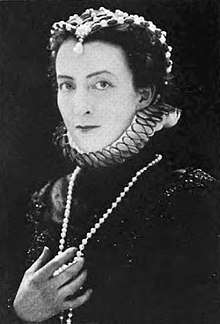
- British playwright John Drinkwater wrote the one-act play Mary Stuart, produced on Broadway in 1921.
- Maxwell Anderson's play Mary of Scotland was produced on Broadway in 1933, starring Helen Hayes.
- The Scottish playwright Robert McLellan depicted the events of Mary's downfall, focussing on the months between March 1566 and June 1567, in his five-act play Mary Stewart (1951), first produced in Glasgow by the Citizens Theatre.
- Sarah Miles portrayed Mary Queen of Scots on Broadway and the West End in the play Vivat! Vivat Regina! (1971) written by her husband Robert Bolt
- Martha Graham choreographed and directed the modern dance titled "Episodes" (1985) that premiered at Lincoln Center, New York, the dance featured Mary Queen of Scots and Elizabeth I resolving their dynastic issues over a game of tennis.
- The Scottish playwright Liz Lochhead explored the relationship between Elizabeth I and Mary Stuart in her play Mary Queen of Scots Got Her Head Chopped Off.
- Mary's imprisonment and trial are the subject of the play (in verse) The Lifeblood by poet Glyn Maxwell.
- Maria Stuart – Königin der Schotten (Waldau Theater Bremen)
- The events of Mary's execution are referenced in playwright Peter Shaffer's play Lettice and Lovage.
Opera
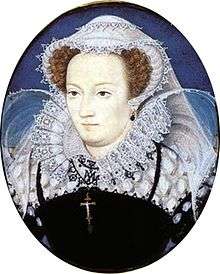
The subject of Mary, Queen of Scots was a common one. Usually the operas dealt with the section of her life when she was being persecuted by Elizabeth I of England. She was considered a sympathetic character in southern Europe due to her Catholicism.
Mary's story proved popular among liberals and revolutionaries in 19th-century Italy. These were especially attracted by the various plots made to save her as well as her death as a political martyr, both of which they interpreted as comparable to their own struggle. The Carbonari took their name from a mythical ring of English coal-burners, supposedly dedicated to Mary's cause. For this reason, the subject of Mary Stuart came to be seen as a concern of radicals, and operas about her were banned on several occasions.[3]
Nineteenth-century operas about Mary include the following:
- Luigi Carlini – Maria Stuarda, regina di Scozia, 1818
- Pietro Casella – Maria Stuarda, 1812
- Coccia – Maria Stuart, regina di Scozia, 1827
- Donizetti – Maria Stuarda, 1835
- Fétis – Marie Stuart en Ecosse, 1823
- Mercadante – Maria Stuarda, regina di Scozia, 1825
- Neidermeyer – Marie Stuart, Paris, 1844
- Pasquale Sogner – Maria Stuarda ossia I carbonari di Scozia, 1816
The American composer Mary Carr Moore completed her opera David Rizzio on an Italian libretto in 1932. Thea Musgrave's opera Mary, Queen of Scots premiered in Edinburgh in 1977.
Poetry
- Shortly after Mary Stuart's execution in 1587, the English Jesuit poet Robert Southwell composed an emblem poem portraying Mary as a Catholic martyr.[4] The poem was never published in the early modern period; even owning a manuscript version of the poem was "inevitable flirtation with treason" in Elizabethan England.[5]
- The 1596 edition of Edmund Spenser's Faerie Queene includes an allegorical representation of the trial of Mary Stuart (Book 5, Canto ix, stanzas 36–50). Mary Stuart is represented by Duessa and Elizabeth is figured by Mercilla. The allegory dwells on Elizabeth's reluctance to condemn Mary. Elizabeth's delay of three months before agreeing to have Mary executed is represented by a gap of three stanzas at the end of Canto ix.[6] Mercilla's judgment and Duessa's execution do not actually occur until the beginning of the next Canto (x.1–4).
- The Spanish poet Lope de Vega wrote an epic poem upon Mary Stuart's life and death: Corona trágica (Tragic crown), published in 1628.
- The Scottish poet Robert Burns wrote a poem Lament of Mary Queen of Scots, on the Approach of Spring upon Mary's feelings while in her captivity in England, towards her cousin Elizabeth I of England and foreboding of her approaching death.
- In Nobel laureate Joseph Brodsky's 20 sonnets to Mary Stuart (in Russian) the poet addresses her as an interlocutor.
Music
- Richard Wagner composed a song "Adieux de Marie Stuart" (WWV 61, 1840) based on a poem by Pierre Jean Béranger).
- Robert Schumann composed a song cycle "Gedichte der Königin Maria Stuart" (Op. 135) based on five poems from the collection "Rose und Distel" by Gisbert Vincke (1852). This cycle was among the final works that Schumann composed before he went insane.
- The American progressive metal band Dream Theater uses a variation of the mark of Mary, Queen of Scots, as their trademark "Majesty" symbol.
- John Barry, composer of the soundtrack to the 1971 film, wrote two songs, "Wish Now Was Then" and "This Way Mary" with lyricist Don Black based on themes from the film. They were performed by Matt Monro, with the latter song covered by Scott Walker and Johnny Mathis amongst others.
- The song "Sad Song" by Lou Reed, featured in the 1973 album Berlin, references Mary in its initial verses. The song was also recorded as a demo by Reed's band The Velvet Underground with different lyrics (this version appears on the box set Peel Slowly and See and the "Fully Loaded Edition" of Loaded, but the Velvets' version still references Mary.
- The song "To France" by Mike Oldfield, featured in the 1984 album Discovery, references Mary in its chorus.
- The song "Fotheringay" by Fairport Convention (with lyrics by Sandy Denny) featured on the 1969 album What We Did on Our Holidays and is an interpretation of the story of Mary's last days in the prison of Fotheringhay Castle. After leaving Fairport Convention, Denny formed a folk rock band named Fotheringay, which released an eponymous debut album Fotheringay in 1970, the cover of which depicted an illustration of the band, including Sandy Denny dressed in Elizabethan costume.
- The song "The Ballad of Mary (Queen of Scots)" by Grave Digger is about her time in prison.
- The song "My Blood Will Live Forever" by Grave Digger is about her time before the execution.
Film
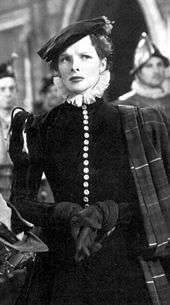
- (1895): The Execution of Mary, Queen of Scots. The first appearance of Mary on film depicts her beheading. It is one of the first films to utilize an intentional jump cut to create the illusion of a single shot beheading. The effect was so convincing at the time that many viewers believed that the actress was actually killed.
- (1923): The Loves of Mary, Queen of Scots, starring Fay Compton.
- (1936): Mary of Scotland starring Katharine Hepburn as Mary, Florence Eldridge as Elizabeth I and Fredric March as Bothwell. The film's screenplay was written by Dudley Nichols, based on the stage play Mary of Scotland, by Maxwell Anderson, which was a Broadway success in 1933.
- (1940): Das Herz der Königin ("The Heart of a Queen") features Zarah Leander, the Swedish-German actress from the Nazi period who plays Mary. This was an UFA production directed by Carl Froelich and making use of the historical story for anti-British propaganda in the context of the then ongoing World War II.
- (1971): Mary, Queen of Scots starring Vanessa Redgrave as Mary, Glenda Jackson as Elizabeth, Patrick McGoohan as Moray, Timothy Dalton as Darnley and Nigel Davenport as Bothwell. Elizabeth and Mary have a private outdoor meeting when Mary arrives in England; later, Elizabeth visits Mary in prison the night before Mary's execution. The film was written by John Hale, who also wrote a novelization of the film's screenplay.
- (1980): The Mirror Crack'd, a Miss Marple mystery, is centered around the making of a motion picture about Elizabeth I and Mary Queen of Scots (this being an example of metafiction, or a film within a film). In this case, the actress playing the actress playing Mary is Elizabeth Taylor.
- (2007): Elizabeth: The Golden Age features Samantha Morton as Mary, Queen of Scots.
- (2013): Mary Queen of Scots, based on Stefan Zweig's 1935 biography, directed by Thomas Imbach, starring the bilingual French actress Camille Rutherford.
- (2018): Mary Queen of Scots, starring Saoirse Ronan as the titular character.
In the 1936 and 1971 film biographies of Mary, fictional meetings between Queens Mary and Elizabeth take place. These historical meetings between the two queens had previously been added for dramatic effect in Schiller's Maria Stuart.
Television
- Gunpowder, Treason & Plot, a 2004 television mini-series by the BBC, dramatized the reigns of Scottish monarchs Mary, Queen of Scots, and her son King James VI of Scotland, who became King James I of England and foiled the Gunpowder Plot. Mary was played by French actress Clémence Poésy.
- In the BBC TV production Elizabeth R, Mary was played by Vivian Pickles. The episode "Horrible Conspiracies" is a generally historically accurate portrayal of Mary during her captivity in England from her imprisonment at Chartley under the guardianship of Paulet through to her trial and execution, using many of Mary's own reported words as dialogue. It includes an accurate portrayal of her execution including her use of a red petticoat (red being the colour of martyrdom in the Catholic religion), her positioning of her head with her hands on the block, and the two blows and sawing motion it took to remove her head. It also shows the executioner unwittingly grasping and pulling away her wig to reveal her grey hair.
- In the Channel 4 miniseries, Elizabeth I, the first two-hour segment partly centers around the conflict between Mary and Elizabeth. Mary is portrayed by actress Barbara Flynn, and her execution is graphically shown, in a manner that is reportedly true to history.
- Monty Python's Flying Circus episode 22 featured a skit involving a "BBC radio drama series" titled "Death of Mary, Queen of Scots".
- A 1957 episode of the Wonderful World of Disney titled, "The Truth About Mother Goose", discussed the origins of three nursery rhymes. Series host Walt Disney attributed the Mary Mary Quite Contrary rhyme to the life of Mary Stuart. This episode featured a brief animated short about Mary's life, done in the artistic style of Sleeping Beauty. The short touched on important moments in Mary's life, even ending with a scene of Mary being marched to her beheading.
- An episode of the British series Lovejoy ("The Colour of Mary", series 4) finds the main character seeking information and the whereabouts of Mary's pool table.
- Lesley Smith, the curator of Tutbury Castle, portrayed Mary Queen of Scots for Living's Most Haunted in 2002 for a dramatic monologue of her time imprisoned there. Smith continues these re-enactments in the castle.
- In the CBBC sketch show Horrible Histories (2009–2015), Mary was portrayed by Martha Howe-Douglas and Jessica Ransom.
- Reign is a highly fictionalized period drama television show on The CW Television Network that follows the life of 15-year-old Mary, Queen of Scots, at French court beginning in 1557, while she awaits her marriage to Francis II of France. At court, Mary has to contend with the changing politics and power plays. Francis' mother, Queen Catherine de' Medici, is secretly trying to prevent the marriage due to the advice of Nostradamus, who had a vision that the wedding will lead to Francis' death. The series also follows the affairs of Mary's four Scottish handmaidens Lola, Kenna, Greer and Aylee, who are searching for husbands of their own at court. Mary is portrayed by Australian actress Adelaide Kane.[7] The series began airing on October 13, 2013.
- Mary is portrayed by Audrey L'Ebrellec in the Channel 5 docudrama series Elizabeth I (2017).
Other
- Singer Tori Amos portrayed Mary Queen of Scots for a photo shoot in late makeup artist Kevyn Aucoin's book Face Forward ( ISBN 0-316-28705-9).
Historical biography and analysis
- Marie Stuart (1936) by Stefan Zweig, ISBN 2-253-15079-7
- Mary Queen of Scots (2006) by Retha Warnicke, ISBN 0-415-29183-6
- Queen of Scots by Rosalind K. Marshall, ISBN 1-873644-95-7
- Mary Queen of Scots by Antonia Fraser, ISBN 0-385-31129-X
- "Mary, Queen of Scots, and the Babington conspiracy", by David Alan Johnson, Military Heritage, August 2005, no. 1, Volume 7, ISSN 1524-8666
- "Mary Queen of Scots and the French Connection", History Today, 54, 7 (July 2004), pp. 37–43, by Alexander Wilkinson
- Elizabeth and Mary: Cousins, Rivals, Queens (Vintage, 2005) by Jane Dunn, ISBN 0-375-70820-0.
- Queen of Scots: The True Life of Mary Stuart (New York, 2004) by John Guy, ISBN 0-618-25411-0
- Mary Queen of Scots and French Public Opinion, 1542–1600 (Palgrave, 2005) by Alexander Wilkinson, ISBN 1-4039-2039-7 (hdbk)
- Mary Queen of Scots: A Study in Failure (London, 1988) by Jenny Wormald, ISBN 0-540-01131-2
- Mary, Queen of Scots, and the Murder of Lord Darnley (New York, 2003) by Alison Weir, ISBN 0-345-43658-X
- The Kings & Queens of Scotland (Stroud, 2004) by Richard Oram, ISBN 0-7524-2971-X
Popular fiction and drama
- Mary, Queen of Scots by Sally Stepanek (young adult fiction)
- Wallenstein and Mary Stuart by Friedrich Schiller
- Full Story Inside, a modern novel by Steve Horsfall
- The Queen's Own Fool by Jane Yolen and Robert J. Harris
- Flawed Enchantress (1973) (in another edition as So Fair and Foul a Queen (1974)) by Maureen Peters
- Immortal Queen by Elizabeth Byrd
- Shadow Queen, a supernatural novel by Tony Gibbs
- The Marchman; Warden of the Queen's March; The Queen's Grace by Nigel Tranter
- Mary Queen of Scotland and the Isles by Margaret George
- Court of Shadows by Cynthia Morgan, a suspense novel
- Fatal Majesty by Reay Tannahill
- Mary, Queen of Scots: A Queen without a country by Kathryn Lasky
- Many plays and films on Elizabeth I (e.g. Elizabeth I) also feature Mary
- The Other Queen – a Philippa Gregory 2008 novel
- A two part saga including: The Royal Road to Fotheringay and The Captive Queen of Scots by Jean Plaidy aka Eleanor Hibbert
- The Memoirs of Mary, Queen of Scots by Carolly Erickson
See also
References
- ↑ http://ibdb.com/production.php?id=481070
- ↑ http://ibdb.com/production.php?id=481070
- ↑ Alexander Weatherson, "Queen of dissent: Mary Stuart and the opera in her honour by Carlo Coccia"
- ↑ "Decease, Release (Dum morior orior)."
- ↑ St. Robert Southwell: Collected Poems. Ed. Peter Davidson and Anne Sweeney. Carcanet Press: Manchester U.K., 2007
- ↑ The Faerie Queene. Ed. A.C. Hamilton. Harlow, UK: Longman, 2001, p. 577 n.
- ↑ http://www.suntimes.com/entertainment/television/24325566-421/australian-actress-secures-her-reign.html